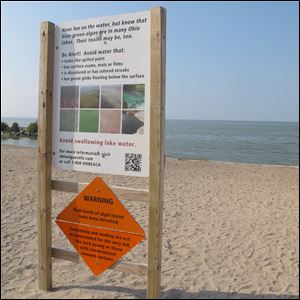
2 Lake Erie beaches still under health advisory
Swimming not recommended because of high levels of microcystin
9/1/2014
Sign warns against swimming and wading at Maumee Bay State park because of the toxic algae bloom.
Two Lake Erie beaches — those at South Bass Island State Park and Maumee Bay State Park — remain under a public health advisory for swimming because of high levels of a serious algal toxin, according to the Ohio Environmental Protection Agency.
The most recent advisory was the one posted Aug. 28 at the South Bass Island State Park beach after a water sample drawn on Aug. 25 showed a concentration of microcystin at 13 parts per billion.
Although that's less than the World Health Organization's threshold of 20 ppb for recreational contact with water, the Ohio EPA said it issues a public health advisory whenever the raw water is 6 ppb or greater as an extra precaution for swimmers who are elderly, young or have compromised immune systems. Wading is not recommended whenever the raw water is 6 ppb or greater.
The advisory applies only to swimming in raw lake water, not to drinking treated tap water.
Microcystin is the chief toxin produced by Lake Erie's most prevalent form of harmful blue-green algae, microcystis, which is actually a bacteria that mimics algae and not a true algae.
The toxin also can be produced by other forms of harmful blue-green algae, such as plantothrix, which is common in the Sandusky Bay region.
Maumee Bay State Park has been under an algae advisory since July 23. It latest sample, drawn Aug. 25, showed a concentration of 6.3 ppb in the raw lake water near its beach.
Maumee Bay State Park's Lake Erie beach also just came out of its latest of 10 advisories this summer for E. coli bacteria, each ranging from one to five days. The latest advisory, lifted Aug. 29, showed bacteria had spiked a day earlier at 517.2 colonies of E. coli per 100 milliliters of water, more than twice the threshold for safe water contact of 235 colonies or less, according to Ohio Department of Health online records.
The park's inland beach came out of its latest of six advisories for high bacteria this summer on Aug. 20, each ranging from one to seven days, ODH records show.
East Harbor State Park in Ottawa County, the state's oldest, continues to be one of its safest in terms of exposure to environmental hazards. No bacteria or algae advisories have been issued at that park in 2014.
South Bass Island State Park has not had an advisory for bacteria this summer — just the recent one for algae, according to state health and environmental protection agency records.
Contact Tom Henry at: thenry@theblade.com or 419-724-6079 or via Twitter @ecowriterohio.